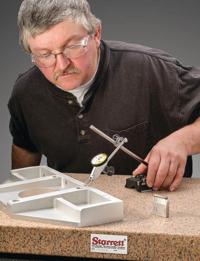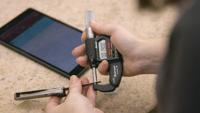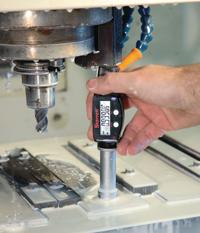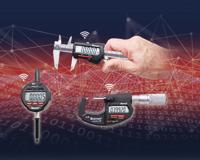
Starrett Test Indicators offer a swivel head feature to allow positioning to suit the technician’s line of sight from horizontal to vertical and at any angle up to 90°. To ensure surface accuracy, measurements are taken on a Starrett Crystal Pink Granite Surface Plate.
There is a wide range of precision measuring tools and gages that should be considered as basic requirements in a metalworking operation for ensuring good quality control (QC) processes. Most gages are available in analog (mechanical readout) or electronic (digital readout with data collecting capabilities), a key requirement for SPC and measurement documentation. Wireless electronic tools are also increasingly an option.
The following is a reference list covering the basic requirements for precision tools:
1. Micrometers: In the hands of a skilled operator, the precision micrometer is the most accurate hand-held tool available. When close measurements to 0.0001" (0.00254 mm) are necessary, the micrometer is the ideal tool for the job because measurement and reading are on the same axis, and the anvil end is supported by a strong frame. There are many types of micrometers depending on the application—inside, disc, blade—with outside micrometers being most commonly used. Mechanical, electronic and wireless micrometers are available, including electronic models that are IP67 compliant. For use in harsh shop environments where machine coolant, water, oils, dirt, dust and mist are prevalent, measuring tools with IP67-level protection ensure that precision gage accuracy, performance and functionality will remain fully intact when subjected to these elements.
2. Slide calipers are an essential precision measuring tool providing a large measurement range, flexibility and accuracy up to 0.001" (25.4 μm). These tools typically measure outside, inside, depth and step dimensions. Full-featured electronic tools, with or without IP67 protection and optional output, are available. In addition to common 6" (152.4 mm), 8" (203.2 mm) and 12" (304.8 mm) tools, large, light carbon fiber models are available, as well as more specialized tools with long jaws, alternative contacts and other variations. Dial calipers are very popular; high-accuracy, extended-range Vernier scale tools are another option. Highly specialized applications may warrant a custom-built slide caliper. Wireless models are also available.

The micrometer is one of the most accurate handheld gages. This Starrett W733.1 Wireless Electronic Micrometer features built-in wireless connectivity.
3. Height gages are an indispensable instrument for QC, measuring the distance from a reference such as a surface plate to some feature of a part with exceptional accuracy. Generally a scriber, test indicator, touch probe or CMM-style probe is used to locate the measured feature.
4. Depth gages are available in varying forms, complexity, cost and accuracy, from the most accurate depth micrometers (electronic, dial and Vernier) to basic rule gages and combination rule gages.
5. Bore gages are used to check inside diameters of holes, cylinders and pipes. When measuring holes, especially when there are a large number of holes, wireless bore gages can easily collect this data. The technology enables users to measure and collect error-free data to output for Statistical Process Control (SPC) analysis and much more. Also, IP67-compliant models are available.
6. Indicators and gages: There are several major classes of gages, including mechanical dial, electronic display, lever-style test and back plunger. Test indicators and dial indicators, in addition to electronic or wireless indicators, are available. Some electronic calipers are IP67 compliant. Indicator requirements can vary widely, from checking runout to measuring tolerances in go/no-go situations, and they are used in multiple applications. It is best to consult a supplier that offers a broad line as well as an extensive range of accessories to configure and position the gage, and, if needed, supply a custom-engineered indicator solution.
7. Hardness and surface testers: Testing the hardness of a material is critical to determining its ability to resist form change, bending, scratching or abrasion. Hardness testers are available in analog and digital bench solutions as well as compact, portable versions. Shore portable hardness testers are targeted for testing materials such as rubber, soft plastics and leather. Versions are also available for testing hard plastics, such as bowling balls and hard hats. Electronic durometers for measuring Shore A and Shore D values in a wide variety of soft materials are offered. Ultrasonic thickness gages measure the thickness of metallic and non-metallic materials. Coating thickness gages use an integrated probe to automatically determine whether the substrate is ferrous or non-ferrous, and then either detect the thickness of non-magnetic coating on a magnetic substrate (ferrous) or the insulating coating on a non-magnetic conductive substrate (non-ferrous). Testing surface roughness is important to determine if a surface is suitable for a particular purpose.
8. Data collection systems: With the IoT and Industry 4.0 being omnipresent new paradigms in manufacturing, increasing the speed, amount and accuracy of data generation is a critical necessity. Precision measurement data acquisition or collection for QC applications benefits significantly from wireless and mobile retrieval. Wireless data collection systems should be mobile and exceptionally robust (with levels of encryption and suitable for multiple needs that include unrestricted distances and gage compatibility) in order to ensure ease of use and practical integration into automated manufacturing operations. Solutions should dramatically increase productivity, reduce errors, provide full documentation and automate the acquisition process.
9. Squares and precision rules, straight edges and parallel: The combination square was invented by the founder of The L.S. Starrett Co., Laroy Starrett, in 1877. The combination square is one of the world’s most practical and versatile tool inventions—the basic tool for every metalworker. A machinist or layout person can use it as a precision rule and measure angles, squares, 45° miters, depths or heights. It can even be used as a scribe. The Starrett Combination Square features high-quality workmanship. The square heads are made of cast iron and a photo-engraved, hardened and tempered steel rule (blade). This remarkable tool is built to last and prized by craftsmen. Accurate, steel precision rules are a staple for a metalworking shop and include photo-engraved graduations. Steel straight-edge versions excel in drawing or scribing straight lines and checking surfaces for straightness. Steel parallels are indispensable for inspection and layout work or for various setups on drill presses, milling and grinding machine shapers and more.

Starrett 770BXT Electronic Bore Gages provide IP67-level protection as well as built-in wireless connectivity.
10. Protractors and angle measurements: A variety of tools are available, some with sharply graduated 180° scales intersected by a movable blade, a bevel protractor, protractor for depth gages, special drill point gages and more.
11. Machinist precision levels: The efficiency of today’s high-speed machinery largely depends on the levelness of the machine setup. A machinist’s level is specially designed to set up, check and test machinery of all types.
12. Fixed gage standards are very useful for in-process and final inspection and include a comprehensive choice of standard gages that quickly check dimensions on a variety of workpieces. Products include pin gages, drill gages, sheet and wire gages, center gages, screw pitch gages, radius gages, ball and diameter gages, angle gages, thickness gages and feeler stock.
13. Dividers, calipers and trammels: Dividers are an essential tool for measuring, transferring or marking off distances. Trammel heads are very useful for laying out and scribing circles beyond the capacity of ordinary dividers. Trammels are used for layout, scribing and measuring distances and circles.
14. Other precision shop tools: Devices such as work positioning tools, scribers, punches and vises, as well as layout die lubricants, do not measure but are an integral part of any shop.
Custom Gaging
There will always be exceptions to exactly what a shop needs for its QC setup. Perhaps a unique measurement solution is in order. In these cases, special custom gaging designed and manufactured for a specific application is an excellent solution when standard products cannot perform. For over 50 years, Starrett has provided special gaging solutions to industries that include energy, aerospace, automotive, food packaging, high-technology plastics and medical components. Solutions have also been supplied to NASA and other government agencies.
Another critical requirement is to have precision reference standards in a shop’s metrology department. Such standards include:
- Gage blocks: Precision gage blocks are the primary standards vital to dimensional quality control in the manufacture of parts. Major characteristics necessary for a precision gage block are accuracy, surface finish, wear resistance, dimensional stability and wringability. (Editor’s note: Wringing is the process of sliding two blocks together so their faces bond. This requires flat surfaces on the order of 0.13 μm and a surface finish Ra of at least 0.025 μm.) Other factors are corrosion resistance, hardness, thermal conductivity and coefficient of expansion. Major types available today include traditional gage blocks made from high-grade steel, which generally are used in shop floor environments, as well as gage blocks made from tungsten carbide, ceramic and chromium carbide.
- Surface plates: Every linear measurement depends on an accurate reference surface from which final dimensions are taken. Precision granite surface plates provide this reference plane for work inspection and layout. A high degree of flatness, overall quality and workmanship also make them ideal bases for mounting mechanical, electronic and optical gaging systems.
Why Go Wireless?
There are many benefits to using wireless gages, whether as individual gages only or used together with an advanced data collection system. Wireless gages are gaining acceptance for the highest levels of QC

Wireless measuring tools eliminate the need for bulky and cumbersome hardware such as backpacks and cables, which can be safety hazards. Technicians press a button to send measurement data to a mobile phone, tablet, or PC.
First and foremost, wireless measuring tools eliminate the need for bulky and cumbersome hardware such as backpacks and cables, which can be safety hazards in a machine shop. That means less equipment to purchase, minimizing startup costs and reducing related maintenance requirements within the manufacturer’s shop tool calibration program.
Collecting and transmitting measurement data is also faster and less error-prone in wireless systems, facilitated simply by measuring and pressing a button to send data to a mobile phone, tablet or PC. In this way, operator subjectivity is removed compared to manually transcribing data.
Also, time spent to manually record the data is no longer a concern. Wireless tools eliminate recoding measurement errors that can occur with manual entries. Wireless provides speed, convenience and ease of collecting and storing data.
Wireless precision measuring tools are engineered for efficient data collection in a wide range of uses. Whether it be for International Organization for Standardization (ISO), government, aerospace or medical requirements, or for smaller shops, the need for accurate data is crucial for traceability to demonstrate qualified parts or to trace back any manufacturing errors to their source. Accurate measurement data provides assurance for the end user and insurance for the manufacturer.
Wireless tools and advanced data-collection software systems can efficiently integrate data in Enterprise Resource Planning/Materials Requirement Planning (ERP/MRP) software systems. Also, wireless gages promote a cleaner work environment by removing the need for a log journal and pens/pencils, making an ideal setup for lean manufacturing.
QC is the last step in producing manufactured parts, screening out bad parts that can hinder assembly of the final product. Using wireless precision gages, inspectors can measure with confidence to qualify parts. With the push of a button, measurement data is archived for later use. The time and money saved by going wireless and implementing a data-collection system is easily measured by digital calculators that demonstrate those savings.













